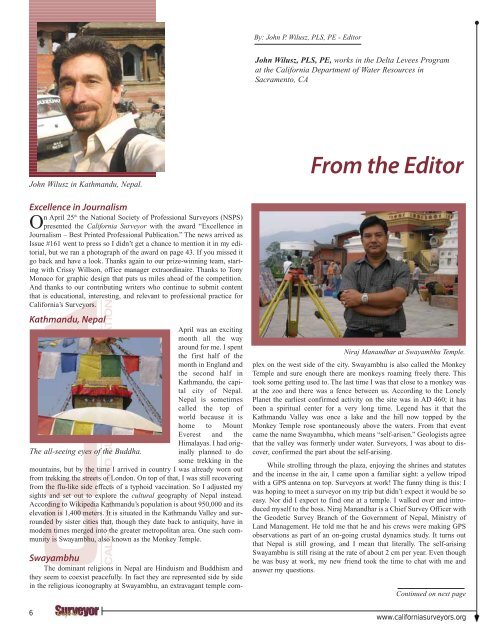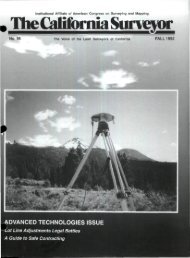The Summer of Living Dangerously (But Safely) - California Land ...
The Summer of Living Dangerously (But Safely) - California Land ...
The Summer of Living Dangerously (But Safely) - California Land ...
You also want an ePaper? Increase the reach of your titles
YUMPU automatically turns print PDFs into web optimized ePapers that Google loves.
John Wilusz in Kathmandu, Nepal.<br />
Excellence in Journalism<br />
On April 25th the National Society <strong>of</strong> Pr<strong>of</strong>essional Surveyors (NSPS)<br />
presented the <strong>California</strong> Surveyor with the award “Excellence in<br />
Journalism – Best Printed Pr<strong>of</strong>essional Publication.” <strong>The</strong> news arrived as<br />
Issue #161 went to press so I didn’t get a chance to mention it in my editorial,<br />
but we ran a photograph <strong>of</strong> the award on page 43. If you missed it<br />
go back and have a look. Thanks again to our prize-winning team, starting<br />
with Crissy Willson, <strong>of</strong>fice manager extraordinaire. Thanks to Tony<br />
Monaco for graphic design that puts us miles ahead <strong>of</strong> the competition.<br />
And thanks to our contributing writers who continue to submit content<br />
that is educational, interesting, and relevant to pr<strong>of</strong>essional practice for<br />
<strong>California</strong>’s Surveyors.<br />
Kathmandu, Nepal<br />
April was an exciting<br />
month all the way<br />
around for me. I spent<br />
the first half <strong>of</strong> the<br />
month in England and<br />
the second half in<br />
Kathmandu, the capital<br />
city <strong>of</strong> Nepal.<br />
Nepal is sometimes<br />
called the top <strong>of</strong><br />
world because it is<br />
home to Mount<br />
Everest and the<br />
Himalayas. I had orig-<br />
<strong>The</strong> all-seeing eyes <strong>of</strong> the Buddha.<br />
inally planned to do<br />
some trekking in the<br />
mountains, but by the time I arrived in country I was already worn out<br />
from trekking the streets <strong>of</strong> London. On top <strong>of</strong> that, I was still recovering<br />
from the flu-like side effects <strong>of</strong> a typhoid vaccination. So I adjusted my<br />
sights and set out to explore the cultural geography <strong>of</strong> Nepal instead.<br />
According to Wikipedia Kathmandu’s population is about 950,000 and its<br />
elevation is 1,400 meters. It is situated in the Kathmandu Valley and surrounded<br />
by sister cities that, though they date back to antiquity, have in<br />
modern times merged into the greater metropolitan area. One such community<br />
is Swayambhu, also known as the Monkey Temple.<br />
Swayambhu<br />
<strong>The</strong> dominant religions in Nepal are Hinduism and Buddhism and<br />
they seem to coexist peacefully. In fact they are represented side by side<br />
in the religious iconography at Swayambhu, an extravagant temple com-<br />
6<br />
By: John P. Wilusz, PLS, PE - Editor<br />
John Wilusz, PLS, PE, works in the Delta Levees Program<br />
at the <strong>California</strong> Department <strong>of</strong> Water Resources in<br />
Sacramento, CA<br />
From the Editor<br />
Niraj Manandhar at Swayambhu Temple.<br />
plex on the west side <strong>of</strong> the city. Swayambhu is also called the Monkey<br />
Temple and sure enough there are monkeys roaming freely there. This<br />
took some getting used to. <strong>The</strong> last time I was that close to a monkey was<br />
at the zoo and there was a fence between us. According to the Lonely<br />
Planet the earliest confirmed activity on the site was in AD 460; it has<br />
been a spiritual center for a very long time. Legend has it that the<br />
Kathmandu Valley was once a lake and the hill now topped by the<br />
Monkey Temple rose spontaneously above the waters. From that event<br />
came the name Swayambhu, which means “self-arisen.” Geologists agree<br />
that the valley was formerly under water. Surveyors, I was about to discover,<br />
confirmed the part about the self-arising.<br />
While strolling through the plaza, enjoying the shrines and statutes<br />
and the incense in the air, I came upon a familiar sight: a yellow tripod<br />
with a GPS antenna on top. Surveyors at work! <strong>The</strong> funny thing is this: I<br />
was hoping to meet a surveyor on my trip but didn’t expect it would be so<br />
easy. Nor did I expect to find one at a temple. I walked over and introduced<br />
myself to the boss. Niraj Manandhar is a Chief Survey Officer with<br />
the Geodetic Survey Branch <strong>of</strong> the Government <strong>of</strong> Nepal, Ministry <strong>of</strong><br />
<strong>Land</strong> Management. He told me that he and his crews were making GPS<br />
observations as part <strong>of</strong> an on-going crustal dynamics study. It turns out<br />
that Nepal is still growing, and I mean that literally. <strong>The</strong> self-arising<br />
Swayambhu is still rising at the rate <strong>of</strong> about 2 cm per year. Even though<br />
he was busy at work, my new friend took the time to chat with me and<br />
answer my questions.<br />
Continued on next page<br />
www.californiasurveyors.org

















